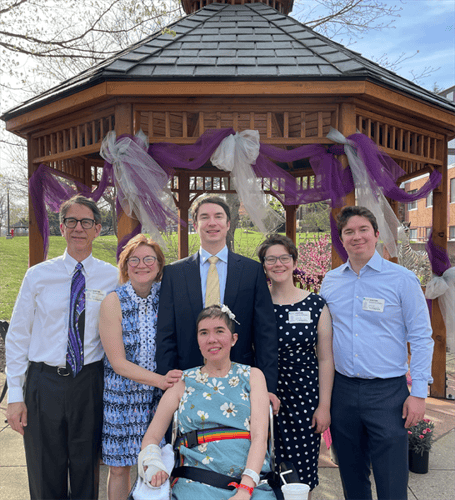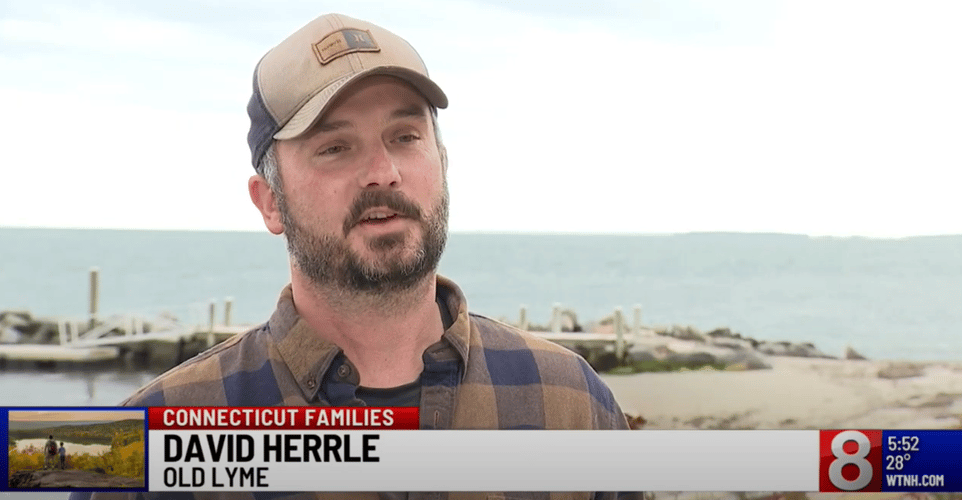In the midst of the 2020 COVID lockdown, 23-year-old Vinny Zelinsky, a recent college graduate, was playing an online video game with friends when he was struck by a sudden blinding headache.
"It felt like an explosion," Vinny recalled. "I’ve had many awful headaches in my life, but nothing like this. My left side felt tingly and then went limp.”
"I knew something was seriously wrong," he admitted. 
At Yale New Haven Hospital, his family received a sobering diagnosis: A complex tangle of blood vessels called an arteriovenous malformation, or AVM, had burst and was hemorrhaging in his brain.
“A Time Bomb … Waiting to Wreak Havoc”
In retrospect, Vinny realizes that one warning sign had been present for years: severe, pounding headaches so bad that he could feel his pulse in his head.
“Pain is such a subjective experience,” he explained. “I always downplayed my concerns to my doctor and didn’t advocate for myself enough to escalate it to the next level. I chalked it up to stress, or maybe I needed more water. I always had some excuse.”
An arteriovenous malformation (AVM) is characterized by an abnormal tangle of blood vessels that disrupts the normal blood flow and oxygen distribution. These improperly formed vessels can sometimes weaken or rupture, leading to bleeding or hemorrhaging.
“Most people can live their whole lives without ever knowing that they have an AVM,” says Dr. Alyse Sicklick, Director of Inpatient Rehabilitation.
A small percentage can have associated symptoms such as seizures or – as in Vinny’s case – intense headaches. According to Johns Hopkins Medicine, fewer than four percent of all AVMs hemorrhage, but those that do can have severe, or even fatal, effects.
"I never imagined I had something like this in my brain, a time bomb just waiting to wreak havoc,” he reflected.
“Keep Pushing Forward”
After two weeks at Yale, Vinny came to Gaylord Hospital to begin an intensive rehabilitation program.
“It was at the height of the COVID pandemic, and visitor restrictions meant I could only see my mom for an hour a day. So my nurses and my therapists became my second family.”
He fondly recounted how Maureen from food and nutrition services would sneak cookies onto his dinner tray and how his favorite nurse, Halina, became his “surrogate” grandmother. Late-night talks – and tears – with Halina were his outlet when “everything felt so heavy.”
“All the nurses took me under their wing. I sat by the nurses’ station to listen to them. They called me their ‘protector,’ but they were the ones who made me feel safe. I leaned on them, and they gladly supported me.”  Vinny recounted how the journey tested him physically.
Vinny recounted how the journey tested him physically.
“I was a wreck. My memory was shot, and I couldn’t move anything on the left side of my body. But I was determined to keep pushing forward, no matter what. I was disoriented; things were not making it from my working memory into my actual memory. So Stefanie from speech therapy gave me helpful workarounds like the WAR acronym – write it down, make an association, and repeat it. It’s hammered into my head and I still use it to this day.”
“Sarah, my physical therapist, got me up and walking. When I left Gaylord Hospital, I was doing stairs with assistance. But my biggest milestone was being able to move my hand. That was huge. Even though I could only close it weakly and barely open it, it was a big, big accomplishment for me and (occupational therapist) Marci.”
“Even my outpatient therapy with Corey in Madison was exceptional. He knew I was an athlete and leveraged that to get me as functional as possible.”
A Force for Good.
Though Vinny appreciated the support and camaraderie he shared with fellow patients in his brain injury group sessions, he noted that most were much older and in different stages of life than he.
“Everyone was super nice, but I wanted to relate to someone more my age. So when my therapists suggested that I become a peer mentor, I jumped at the chance to help younger people like me.”
A year after his injury, Vinny became a peer mentor volunteer, bringing support and encouragement to Gaylord Hospital patients with brain injury and stroke. One particular visit, he said, moved him profoundly.
“I met someone my age who had endured a similar injury. I looked them in the eye and said, ‘I understand how overwhelming this can be, but trust these people—they helped me, and they can help you, too.’”
“Being able to offer that support was my proudest moment. It wasn’t just about helping someone else; I was also healing the lonely, scared version of myself.”
No Limits.
Vinny also became involved with The Aneurysm and AVM Foundation (TAAF), where he found a community of individuals who support each other through their recovery journeys.
"Through TAAF, I've met many amazing people who inspire me to keep pushing forward. But I was disheartened to hear that not everybody has had the positive and encouraging rehab experience that I did.”
“So many survivors I talked with were told limiting things, like ‘you’re paralyzed’ or that they ‘can’t’ do something,” he explained.
“I never heard the words ‘paralyzed’ or ‘can’t’ at Gaylord. Instead, they focused on ‘we’re going to work on this’ or ‘we’re going to get your function back.’ No one ever presented a hard limit. Hearing their stories made me appreciate Gaylord even more.”
“Gaylord’s staff are the reason behind my success,” he asserted. “I know it sounds trite, but it all goes back to Gaylord’s motto of ‘Think Possible.’ Nothing was ever presented to me as impossible. The sky was the limit, so I shot for the moon, and I ended up better than I ever thought I could!”

